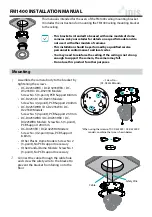
EnergyCell Batteries
900-0227-01-00 Rev A
9
Figure 4
Parallel String Configuration
Figure 5
Series/Parallel String Configurations
Batteries are placed in parallel (positive to positive,
negative to negative) for additive amp-hour capacity.
Three batteries in parallel have three times the
amp-hours of a single battery. However, batteries in
parallel do not have additive voltages. A single set of
batteries in parallel (as shown in this figure) have the
same voltage as a single battery.
NOTE
:
Use caution when designing or building
systems with more than three EnergyCell batteries or
strings in parallel. The extra conductors and
connections used in larger paralleled systems can lead
to unexpected resistances and imbalances between
batteries. Without proper precautions, these factors will
reduce the system efficiency and shorten the life of all
batteries. For systems beyond three strings, contact an
OutBack representative.
Parallel
Load Bus +
Load Bus –
Load Bus –
Load Bus +
Load Bus –
Load Bus +
Batteries are placed in both series and parallel for both additive voltage and amp-hour capacity.
Series strings placed in parallel have the same nominal voltage as each string. They have the same
amp-hour capacity of each string added together. Two parallel strings of two EnergyCell batteries in
series have a nominal voltage of 24 Vdc, twice the nominal voltage. They also have double the
amp-hour capacity of a single battery. Two parallel strings of four batteries in series have a nominal
voltage of 48 Vdc at double the amp-hour capacity of a single battery.
In a series-parallel bank, it is not recommended to connect the load to the positive and negative
terminals of a single string. Due to cable resistance, this will tend to put more wear on that string.
Instead, it is recommended to use “reverse-return” or “cross-corner” wiring, where the positive cable is
connected to the first string and the negative is connected to the last. This will allow current to flow
evenly among all strings.






































